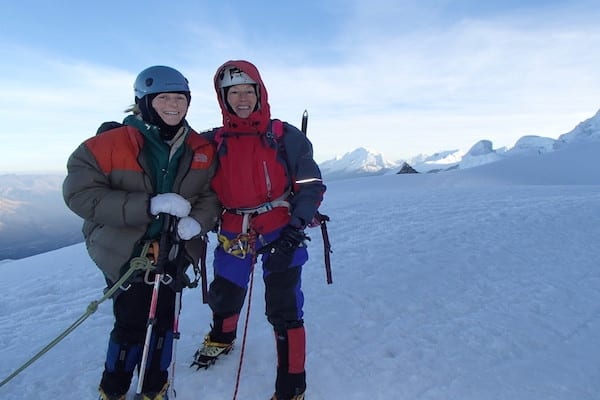
Five years ago, while attempting to climb the North Col of Everest, I thought I might die.
Alone in my tiny yellow tent at Advance Base Camp, surrounded by ice-blue cliffs in the shadow of the world’s highest mountain, I spent three nights too frightened to sleep, needing every ounce of my will to breathe.
I contemplated death as I sat propped against my backpack while roaring wind gusts sent shards of ice tumbling onto my artic sleeping bag. Thoughts of my nine, 16 and 18-year-old kids kept me focused. I forced the thin air into my lungs with all my might. Every breath was life. I knew if I could survive the night, I’d be okay. The night always brings the greatest fear.
I can’t imagine what it was like for 34-year-old Aussie doctor Maria Strydom, who died on Saturday after failing to reach the summit of Everest. But the grief her husband felt as he held her in his arms couldn’t have been worse.
Her death has reignited an Everest debate that strikes at the heart of all extreme sports. Of course, what has happened to Maria is devastating, for her family, friends and loved ones. But did she die doing something she loved knowing the risks involved? Yes.
Dangerous sports such as sky diving, bull riding, luging, mountaineering, rock fishing and scuba diving can kill you. Dangerous sports can also give you an exciting, exhilarating life, a high unmatched by drugs and other addictive activities.
In spite of the known risks, around 800 people attempt Everest annually. 50 percent summit and around one percent die. They climb it to test themselves in nature, to feel the exhilaration that comes from overcoming a huge challenge in the wilderness, to motivate themselves to stay strong and fit and to overcome fear. As Sir Edmund Hillary famously said: “It is not the mountain we conquer, but ourselves.”
Of course, my kids never wanted me to go. But this climb was part of a team Seven Summits challenge. I’d been training for it for 10 years. I was totally consumed preparing my gear, my body and mind for the extreme adventure. I was keen to inspire other over fifties mums to achieve extraordinary goals that motivate them to stay healthy and strong.
My 16-year-old daughter was almost hysterical when I boarded the plane. She knew it was dangerous and she said I was mad. I told her I could manage the risk. I cited statistics, explaining that it was more dangerous riding my bike down to the local shops on a busy road.
Fortunately, I didn’t die that night. The team doctor said I had altitude sickness and insisted a Sherpa guide take me down to Base Camp immediately. But that experience scared me into removing Everest from my list of motherly self-care activities.
But should we stop hundreds of fit, amateur mountaineers from spending around $50,000 each on their Everest dreams and endangering their own and their Sherpa guide’s lives?
Famous Australian mountaineer, Lincoln Hall, ‘died’ on Everest in 2010, was rescued, came back to life and died from mesothelioma a few years later. I imagine he was thrilled to have experienced a lifelong dream, but it would have been hell for his wife and children.
Lincoln’s friend and fellow Everest summiteer, Cheryl Bart, says: “When people ask me if I have a death wish, I say ‘No, I have a life wish’.”
The Everest trekking trade brings money to the Himalaya. The villages above Lukla where the adventurers start their trek are wealthy by local standards. By contrast, those villages below Lukla are dirt poor, few kids get an education and they rely on western aid to survive.
The Australian Himalayan Foundation, which provides millions of dollars for education in Nepal, is run by Everest summiteers. Standing on heaven’s doorstep on top of the world drives you to join a community devoted to helping the local people.
When I climbed to the summit of Mt Ama Dablam (6,812 metres), in the Everest region, I was guided by an extraordinary 21-year-old, Tensing Sherpa. He was strong, resilient, kind, generous and wise beyond his years. Climbing Everest gave him a career and made him a local hero.
Climbing Everest isn’t everybody’s cup of chai. But it symbolises one of life’s great adventures and it sure beats the hell out of joining the almost 40 million people who die of noncommunicable diseases every year.
Check out Wild Women On Top on Facebook.

